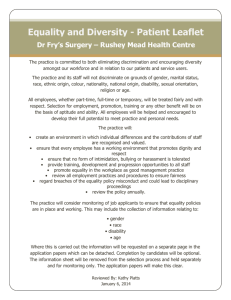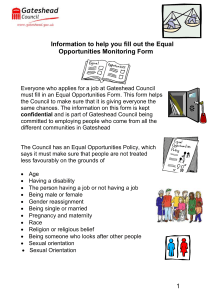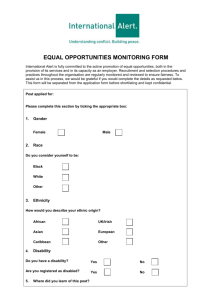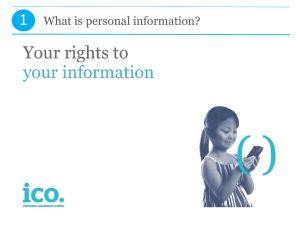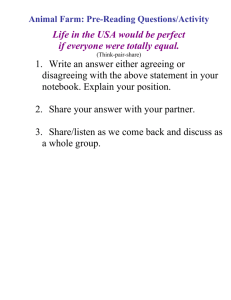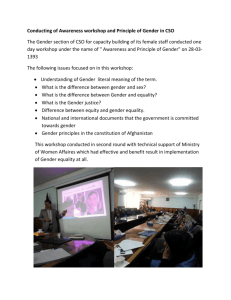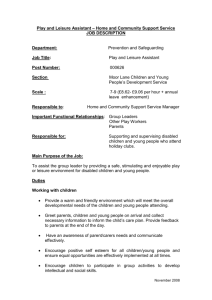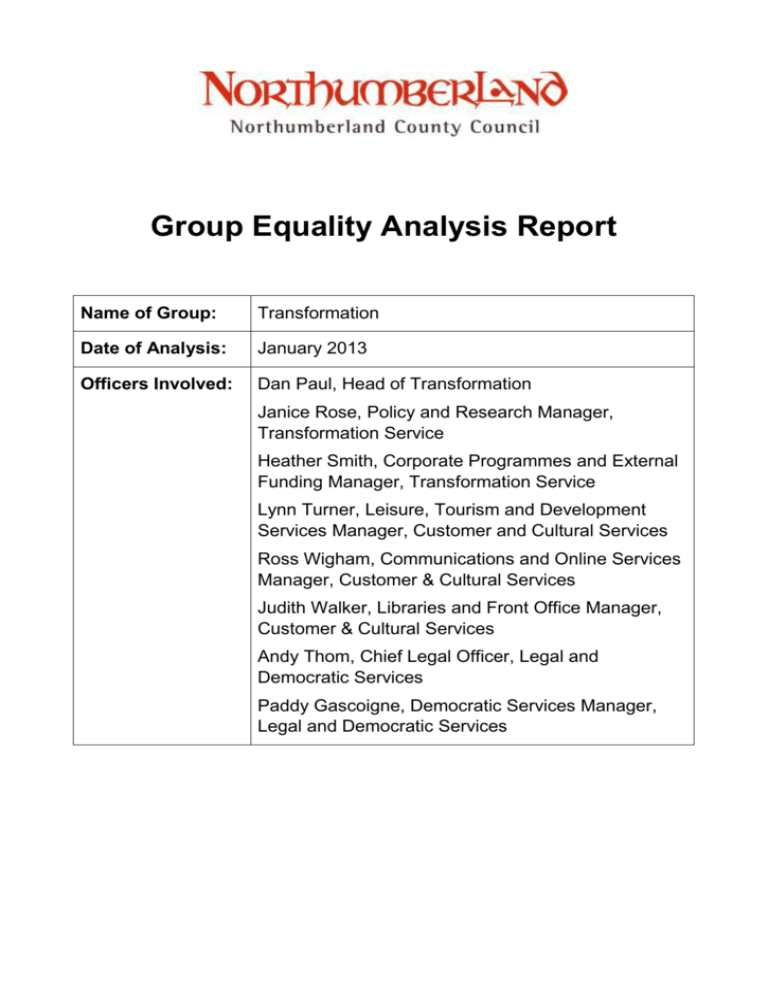
Group Equality Analysis Report
Name of Group:
Transformation
Date of Analysis:
January 2013
Officers Involved:
Dan Paul, Head of Transformation
Janice Rose, Policy and Research Manager,
Transformation Service
Heather Smith, Corporate Programmes and External
Funding Manager, Transformation Service
Lynn Turner, Leisure, Tourism and Development
Services Manager, Customer and Cultural Services
Ross Wigham, Communications and Online Services
Manager, Customer & Cultural Services
Judith Walker, Libraries and Front Office Manager,
Customer & Cultural Services
Andy Thom, Chief Legal Officer, Legal and
Democratic Services
Paddy Gascoigne, Democratic Services Manager,
Legal and Democratic Services
Contents
PART 1 – Overview of the Group’s Key Functions and Services .............................. 1
PART 2 – Information Analysis ..................................................................................... 2
1.
Disability ................................................................................................................ 2
2.
Sex ........................................................................................................................ 5
3.
Race ...................................................................................................................... 7
4.
Sexual Orientation ................................................................................................. 8
5.
Age ........................................................................................................................ 9
6.
Religion and Belief .............................................................................................. 11
7.
Transgender ........................................................................................................ 12
8.
Pregnancy and Maternity..................................................................................... 12
Addressing the data gaps ........................................................................................... 13
Key equality issues ..................................................................................................... 13
PART 3 – Equality Objectives ..................................................................................... 15
PART 1 – Overview of the Group’s Key Functions and Services
The Transformation Group is made up of:
Customer and Cultural Services – which includes Customer Services, Registrars
and Coroners, Libraries, Cultural Services, Corporate Communications, Tourism and
Leisure.
Information Services – with our internal ICT support desk, infrastructure and
development staff, business partners and systems analysts geared to support and
develop our system to meet business need
Legal and Democratic Services – which includes Legal Services, Committee
Services, Scrutiny, Elections and Member Support
Transformation Service – which includes Human Resources, Organisational
Development, Policy and Research and the Transformation Programme and
Projects team
The vast majority of the services within the Group provide internal support to the Council
and as such do not have a direct interface with the public. The one notable exception to
this is Customer and Cultural Services which spans a number of functions which are
universally open to all residents of the county. Equally, within the Legal and Democratic
Service, the running of local elections is delivered direct to all those entitled to vote. It
should also be noted that the Transformation Service supports the voluntary and
community sector to coordinate a VCS-led Single Equality Network.
Within this, it should be noted that certain functions within Customer and Cultural
Services are delivered by partners through a variety of different arrangements. Some
are offered grants or payments linked to a Service Level Agreement. In other cases,
formal contract arrangements are in place. In these circumstances, the Council’s role is
one of ensuring that these third parties deliver their obligations in relation to equality and
diversity.
The customer-facing services of the Transformation Group have the most significant
impact on those with a disability. On this basis, the “generic” equality and diversity
activity that is ongoing and planned is detailed within that section of the EIA. This
activity will apply to all of the protected groups with this approach adopted for the EIA to
avoid a great deal of repetition.
In addition, the Transformation Service has completed a separate equality analysis in
respect of the Human Resources policies that cover the Council’s workforce.
1
PART 2 – Information Analysis
1.
Disability
1.1
What do we know?
In Northumberland, 21% of the population considers themselves to have a disability or a
long-term limiting illness, compared to 18% of the national population.
In relation to participation in physical activity, customer information is regularly collected
by the leisure centre operators as to who is using the facilities. For example, in 2013,
4.6% of North Country Leisure (NCL) leisure card holders are disabled peopled. This
information is also supplemented by a national Sport England “Active People”
participation survey. The 2010 figures illustrated that 8% of the population which
defined itself as having a limiting long-standing illness, disability or infirmity (but it should
be noted that the numbers involved in the survey were very small at the Northumberland
level) had participated in moderate physical exercise on a regular basis. This is similar
to the regional average but below the comparable national average.
A survey of library users in 2009, confirmed that most respondents did not have any
disabilities or a long-term limiting illness; but for those that did, the most common issue
raised related to accessibility/mobility.
1.2
What are the key impacts on disabled peopled people?
Disabled peopled people face a range of barriers in accessing services including:
physical and environmental barriers (such as poor access to buildings); communication
barriers (such as poor access to BSL interpreting, accessible information, loop systems
etc.); social inclusion barriers (such as poor access to public transport and community
facilities); and attitudinal barriers.
1.3
What do we have in place?
Arts and cultural buildings are generally accessible, given the constraints of historic
buildings in which some services are located. Physical barriers are addressed through
automatic doors, lifts and Braille signage. Venues also offer audio loops for hearing
impaired audiences and Sign language performances. The Council also works closely
with leisure providers to ensure that access to buildings is as inclusive as possible in line
with current disability access requirements. Equally, where physically possible Tourist
Information Centres (TICS) have level or ramped access and the layouts meet the
requirements for wheelchair access. The TICs also provide accessibility information for
attractions and accommodation providers.
This work has been aided by the development through the Disabled peopled Go project
of an access guide to over 1000 buildings of community relevance across
Northumberland.
2
The National Accessible Scheme is also promoted via the Tourist Information Service
and Northumberland Tourism to ensure that high standards of accessibility to tourist
accommodation are maintained for visitors to Northumberland.
In addition, there are nine Customer Information Services across the county who deliver
face to face services to customers. These meet disability access requirements whilst
the central Contact Centre has a separate text phone number to support customers with
hearing difficulties.
The Council’s four Registrars Offices also meet disability access requirements. The
registration service approves venues to allow the conducting of wedding and civil
partnership ceremonies. These individual locations are responsible for the disability
access compliance of their facilities. However, they are encouraged to provide facilities
for disabled peopled guests wherever possible and a checklist is to be provided as part
of the approved licensing pack to be launched in spring 2012.
All of the material produced by the Service is available (on request) in alternative
formats (large print, Braille, audio books, etc). In addition, a central design team is
trained in accessibility and disability access issues and ensures that all corporate
posters, magazine, fliers, brochures etc – including the corporate magazine which is a
key point of information for residents – are accessible. Images on the library website are
checked for colour contrast to ensure they work for visually impaired users. The centrally
hosted Council website is meets industry standard equality measures.
The library service has a selection of books in large print as well as a range of audio
books and publications in Braille, which are highlighted on the library website, each with
their own page and are regularly featured in library promotions. The school’s library
service offers tailored support for children with learning disabilities. In addition, the
service visits almost 150 customers who are unable to visit their local library (a full
review of this area of the service was completed in December 2011.
The Council also contributes or runs certain programmes that encourage participation in
cultural and leisure activity. Examples include:
The development of Pegasus Centre, Riding for the Disabled peopled
Community based cardiac rehabilitation sessions and exercise on referral schemes
which have a high uptake from disabled peopled people
Arranging (through Northumberland Sport and its other three equivalents in the
region) the annual North East Disability Sports Awards – these recognise and
celebrate the achievements of disabled peopled people who have made a significant
contribution to sport
Working with local partners to improve the provision of sport and physical activity for
disabled peopled people. Northumberland Sport also supports the Schools Games
“Local Organising Committee” to deliver the national School Games programme in
Northumberland. This is designed to enable every school and child to participate in
competitive sport, including meaningful opportunities for disabled peopled young
people.
3
The key arts and heritage venues deliver targeted events and activities to encourage
engagement and interaction with protected groups. For example, Woodhorn
Museum arranges tours in sign language for hearing impaired groups.
A visually impaired reading group meets at Morpeth library.
A number of leisure centres run the accredited “Inclusive Fitness” initiative.
The Ability to Play programme delivers a range of needs led interventions targeting
disabled peopled young people and their families.
£300,000 has been secured by Blyth Valley Arts and Leisure (BVAL) from the Big
Lottery to develop community inclusion programmes with the aim of improved health
and wellbeing, targeting young people, disabled peopled people, and women and
girls living in south east Northumberland’s most deprived areas.
The council’s Chief Executive is the returning officer and electoral registration officer for
national and local elections. The law requires that the returning officer designates
polling stations which are accessible to electors by meeting criteria set by the Electoral
Commission. This achieved by:
The election staff inspecting a premises before it is designated as a polling place
Carrying out a formal review of polling places every five years in consultation with
disability groups
Polling inspectors and polling staff checking accessibility at each election and
reporting any issues to the Election Office
Training new polling staff so that they are conversant with accessibility issues and
how they can assist electors
Providing refreshers for existing polling staff at briefings before each election
Making the following equipment available at each station: Polling booth(s) for
wheelchair users; Large print ballot papers; Templates for blind and partially sighted
electors; and Ramps (if necessary)
The Election Office can supply elector information in Braille or audio on request.
Election staff will also visit disabled peopled electors in their homes if they need
assistance completing postal votes
1.4
What else do we need to do?
The Library service has been working to improve access at all 34 locations. Bellingham
Library, for example, has moved from a second floor property with no lift access to a
ground floor location in the Town Hall and is now more accessible. However, in order to
assess progress on this work, a full inspection of library properties and services is
underway and will be completed by the end of February 2013.
An audit of Tourist Information Centres is being carried out to identify improvements
required. Improvements such as signage, ramps and bells are being implemented as
appropriate.
4
Owing to its age and lack of previous investment Ashington Leisure Centre is no longer
fit for purpose. The Council is therefore investing £20 million in a new community and
leisure facility to meet the needs of the people who live, work and study in Ashington.
The outcome will be an integrated offer which stimulates health and wellbeing through
access to information and services as well as encouraging participation in healthy
activities. It will be designed to ensure that is it accessible to all and that use by under
represented groups is encouraged.
Steps are being taken to provide a face to face service for people within the deaf
community. This will be offered through the 9 Customer Service information centres,
with a lighter service provided through the network of libraries. In addition, whilst a text
phone service is provided via the contact centre, this facility needs to be expanded
across the authority. To this end, a SMS solution which will provide benefit to all service
users is being explored.
As part of the Annual Review with cultural delivery partners, further information is being
requested on how those providers are implementing their equality policies in relation to
participation and engagement. This will include encouraging partnerships with
national/regional organisations such as Disability Arts and Disability North. In addition all
leisure and cultural venues have been asked to collect information on use by protected
groups where this is feasible.
A corporate customer satisfaction survey is due to be rolled out shortly which will
monitor use and satisfaction broken down by age, gender, disability, and ethnic group.
This will improve the level of information we have in relation to protected groups and
enable us to plan services accordingly.
A programme of briefing and training for both frontline and managerial staff to raise
awareness of equality and diversity issues is being put in place to ensure that we are
able to consider and meet the needs of all the protected groups effectively.
Due to the size of Northumberland and it’s largely rural nature the Returning Officer is
forced to use some premises which are not fully accessible because there are no
alternatives. This can include using portakabins. The Election Office reviews these
locations to see if alternatives do become available over time.
2.
Sex
2.1
What do we know?
More men than women participate in moderate exercise on a regular basis. However,
Northumberland’s levels of female participation are higher than the regional average and
the gap between male and female participation ids reducing according to the Sport
England survey. The breakdown of participants for GP Referrals at North Country
Leisure facilities is 44% male and 56% female.
5
From the response to the survey of library users, more women (62%) are customers of
the library service than men.
2.2
What are the key impacts on men and women?
Whilst services are equally available to men and women, it is important to acknowledge
that they may need to be promoted or provided differently to men and women in order to
achieve the same outcomes. For example, they may have different “motivators” or may
be uncomfortable exercising in front of the opposite sex.
2.3
What do we have in place?
When developing leisure programmes of activity, account is taken of the different
interests and motivations of men and women; e.g. specific sessions and classes are run
within the leisure centres which are open to women only. A targeted swimming and
aquatics programme is also being developed to encourage more women to take up
swimming activities on a regular basis.
£300,000 has been secured by BVAL from the Big Lottery to develop community
inclusion programmes with the aim of improved health and wellbeing, targeting young
people, disabled peopled people, and women and girl’s living in South East
Northumberland’s most deprived areas.
The library service has recently reviewed the way it purchases books and other stock
and is introducing more scope for readers to influence stock selection. Many libraries
arrange their stock into areas that appeal to target groups including men and women.
Making buildings accessible has benefits for all sections of society and is also
particularly helpful for mothers with young children, pushchairs and buggies.
Both women and men can benefit from the mobile library service and the home library
service (which visits those who cannot leave their homes). Within an ageing population
these services are particularly beneficial to women who are over-represented within the
older age groups.
The Schools Library Service works with schools to encourage boys’ reading. Whilst the
library staff at HMP Northumberland participate in the National Storybook Dad’s service
which encourages prisoners to record stories for their children. In addition, the library
website has featured a boys reading promotion.
2.4
What else do we need to do?
The library service is planning to keep exploring attitudes and perceptions of the service
to ensure that it appeals to both genders and all ages – and will particularly explore
initiatives that attract men and boys to use the service more. This will include looking at
best practice from other places and seeing if this can be replicated in Northumberland.
6
As part of the Annual Review with cultural delivery partners, further information is being
requested on how those providers are implementing their equality policies in relation to
participation and engagement. In addition all leisure and cultural venues have been
asked to collect information on use by protected groups where this is feasible.
A corporate customer satisfaction survey is due to be rolled out shortly which will
monitor use and satisfaction broken down by age, gender, disability, and ethnic group.
This will improve the level of information we have in relation to protected groups and
enable us to plan services accordingly.
A programme of briefing and training for both frontline and managerial staff to raise
awareness of equality and diversity issues is being put in place to ensure that we are
able to consider and meet the needs of all the protected groups effectively.
3.
Race
3.1
What do we know?
With less than 2% of the population not classified as “White British”, it is very difficult to
provide robust information to compare with participation levels in moderate exercise at
regional or national average. Figures contained in the recent Sport England Survey are
too small to be statistically significant.
Less than 5% of those who use libraries describe themselves as being from an ethnic
minority, with the single biggest population (1.1%) being Irish.
3.2
What are the key impacts on people from different racial groups?
Whilst services are equally available to individuals from all ethnic groups, it is important
to acknowledge that they may need to be promoted or provided differently to certain
ethnic minority groups in order to achieve the same outcomes.
Given the race profile of Northumberland, there may be a shortage of culturally
appropriate services available locally. There may also be a need to arrange access to
an interpreter for certain functions within the Service.
3.3
What do we have in place?
Certain spaces within the leisure centres have been designed to enable use by different
groups, including ethnic minority groups.
The library service provides supported access to a series of “Clarity English” computerbased courses for those individuals who have English as their second language. These
have been run frequently to reflect demand:
Tense Buster – this course has been accessed 271 times in the last year
Active Reading – this course has been accessed 77 times in the last year
7
In addition, through a community adviser dedicated to engaging with the “hard to reach”,
the library service is regularly represented at group meetings that bring together the
migrant population; part of this input is to signpost individuals to the Clarity English
courses and the ESOL programme at Northumberland College. The Schools Library
service has a selection of books in community languages for young children in schools
who have English as an additional language.
All of the material produced by Customer and Cultural Services is available (on request)
in different languages. Similarly the Election Office is able to provide voter and
registration information in different languages on request.
3.4
What else do we need to do?
As part of the Annual Review with cultural delivery partners, further information is being
requested on how those providers are implementing their equality policies in relation to
participation and engagement. In addition all leisure and cultural venues have been
asked to collect information on use by protected groups where this is feasible.
A corporate customer satisfaction survey is due to be rolled out shortly which will
monitor use and satisfaction broken down by age, gender, disability, and ethnic group.
This will improve the level of information we have in relation to protected groups and
enable us to plan services accordingly.
A programme of briefing and training for both frontline and managerial staff to raise
awareness of equality and diversity issues is being put in place to ensure that we are
able to consider and meet the needs of all the protected groups effectively.
4.
Sexual Orientation
4.1
What do we know?
The survey of library users in 2009 indicated that 80% of respondents were heterosexual
but it should be noted that a high number of respondents queried the appropriateness
and relevance of this question and as such there was an element of non-response.
The Service does not hold any further customer information relating to sexual
orientation.
4.2
What are the key impacts on people of different sexual orientations?
The interests and types of activities that people may want to engage in are likely to differ
depending on the sexual orientation of the person and so services need to take account
of this and provide services that are appropriate. Within this, however, it is considered
the impact of the Group’s activity with respect to this population is not significant.
8
4.3
What do we have in place?
The Registration Service actively promotes Northumberland for the holding of civil
partnership ceremonies – this includes the production of civil partnership brochures at
wedding fairs and attendance at an annual gay and lesbian event in Newcastle.
However, the actual number of civil partnerships that have being conducted is low.
4.4
What else do we need to do?
The Group’s impact on people with different sexual orientation will be kept under review
as we recognise that this is an area where we have data gaps to address which will help
inform our action plan moving forward.
A programme of briefing and training for both frontline and managerial staff to raise
awareness of equality and diversity issues is being put in place to ensure that we are
able to consider and meet the needs of all the protected groups effectively.
5.
Age
5.1
What do we know?
Participation in physical activity decreases as people become older. Around 30% of 1649 year olds in Northumberland regularly participate in moderate physical activity. This
reduces to 15% for people aged over 50. This figure is higher than both the regional
and national average.
In 2011/12, 24% of North Country Leisure users were under 16, 52% were 17-59 years
old, and 24% were 60 or over.
The age profile of library users is predominantly over 60 years of age (46%); with the 1630 age group under-represented with only 7% of respondents.
National research has indicated that about 75% of electors aged over 55 voted in the
2010 General Election whilst the figure for the 18 to 24 age group was 44%.
5.2
What are the key impacts on people of different ages?
The interests and type of activities that people may want to engage in are likely to differ
depending on the age of the person and so services need to take account of this and
provide age appropriate services.
5.3
What do we have in place?
A programme of accessible holiday and extra curricular school activities and events
particularly targeted at young people are provided in the leisure centres.
Specific sessions and classes are run within the leisure centres which are targeted at
older people.
9
Within leisure, partnership working with public health has enabled the delivery of
community based cardiac rehabilitation sessions and exercise on referral schemes.
These are available to all age groups, but are particularly well used by older people.
£300,000 has been secured by BVAL from the Big Lottery to develop community
inclusion programmes with the aim of improved health and wellbeing, targeting young
people, disabled peopled people, and women and girl’s living in South East
Northumberland’s most deprived areas.
“All about me” and MEND (mind, exercise, nutrition, do it) programmes are being
delivered to young females and 17-13 year olds to address issues of self-esteem,
obesity and weight issues.
Most libraries have dedicated children’s areas with specific stock that meets their
interests – this includes material aimed at teenage or young adult readers. The library
website offers reading suggestions for children and young people who are also
encouraged to submit book reviews. Events are also held to attract families and younger
users such as participation in Bookstart and the Summer Reading Challenge.
The library service is also aware that services such as the mobile library service and the
home library service (which delivers to people who cannot leave their homes) are
particularly important to older people who find mobility an increasing difficulty and takes
this into account when reviewing the service.
Libraries also understand their role in social inclusion, particularly for older people, who
value their visits to libraries for social interaction and quality of life as well as for reading
for pleasure and learning.
Making our buildings accessible is important to older people who may not necessarily
consider themselves to have a disability, and initiatives and plans in this area will also
have a beneficial impact on older residents.
The Council’s strategic vision for customer services includes the continuing importance
of face to face contact. We recognise that, while many younger people will increasing
turn to quick and easy online forms of access, an older generation values being able to
speak to a ‘real’ person when trying to access services.
The County Council is actively trying to age young people to become involved in the
democratic process. It starts at an early age by inviting primary schools to visit County
Hall and pose questions to senior councillors about its role. Democratic Services also
does the following:
Print ballot papers and lends polling equipment for school council elections
Organises mock elections in schools in conjunction with Youth Cabinet members
Conducts the Youth Cabinet/Youth Parliament elections involving high schools
across the county
Runs democracy workshops for young people aged 16 to 25.
10
5.4
What else do we need to do?
The Group will continue to maintain the tailored activity outlined above – as well as
explore ways to further expand its breath and coverage. This will include looking at best
practice from other places and seeing if this can be replicated in Northumberland.
As part of the Annual Review with cultural delivery partners, further information is being
requested on how those providers are implementing their equality policies in relation to
participation and engagement. In addition all leisure and cultural venues has been
asked to collect information on use by protected groups where this is feasible.
A corporate customer satisfaction survey is due to be rolled out shortly which will
monitor use and satisfaction broken down by age, gender, disability, and ethnic group.
This will improve the level of information we have in relation to protected groups and
enable us to plan services accordingly.
A programme of briefing and training for both frontline and managerial staff to raise
awareness of equality and diversity issues is being put in place to ensure that we are
able to consider and meet the needs of all the protected groups effectively.
6.
Religion and Belief
6.1
What do we know?
The vast majority of library users are Christians (63%) but it should be noted that a high
number of respondents queried the appropriateness and relevance of this question and
as such there was an element of non-response.
The Service does not hold any further customer information relating to religion or belief.
6.2
What are the key impacts on people with different religions and
beliefs?
For people of certain religions, specific days/times are considered to be sacred;
therefore services may need to take account of the timing of initiatives and activities to
ensure they do not conflict with any religious requirements. Within this, however, it is
considered the impact of the Group’s activity with respect to this population is not
significant.
6.3
What do we have in place?
The Registration Service actively promotes Northumberland for the holding of civil
partnership ceremonies for those that do not believe in religious wedding ceremonies.
6.4
What else do we need to do?
The Group’s impact on people of different religion and belief will be kept under review as
we recognise that this is an area where have data gaps to address which will help inform
our action plan moving forward.
11
A programme of briefing and training for both frontline and managerial staff to raise
awareness of equality and diversity issues is being put in place to ensure that we are
able to consider and meet the needs of all the protected groups effectively.
7.
Transgender
7.1
What do we know?
The Service does not hold any customer information relating to transgender.
7.2
What are the key impacts on transpeople?
The services provided by the Group need to sensitively respect the needs of
transpeople.
7.3
What do we have in place?
Many of the Council’s leisure facilities provide individual cubicles within the changing
room areas.
7.4
What else do we need to do?
The Group’s impact on transpeople will be kept under review as we recognise that this is
an area where have data gaps to address which will help inform our action plan moving
forward.
A programme of briefing and training for both frontline and managerial staff to raise
awareness of equality and diversity issues is being put in place to ensure that we are
able to consider and meet the needs of all the protected groups effectively.
8.
Pregnancy and Maternity
8.1
What do we know?
The Service does not hold any customer information relating to pregnancy and
maternity.
8.2
What are the key impacts around pregnancy and maternity?
Pregnant women may feel fatigued or unwell when accessing facilities provided by the
Service.
8.3
What do we have in place?
Pregnant women will (on request) have access to a quiet room if they feel fatigued or
unwell while visiting Customer and Cultural Service facilities.
In addition, two of the county’s leisure facilities (in Alnwick and Berwick) run specific
weekly "Aqua Natal" sessions.
Books on pregnancy and parenting skills have been promoted on the library website.
12
With many of the Group’s buildings and venues offering improved accessibility, families
with pushchairs and buggies can readily gain easy access.
8.4
What else do we need to do?
The Group’s impact on pregnancy women and individuals with maternity needs will be
kept under review.
A programme of briefing and training for both frontline and managerial staff to raise
awareness of equality and diversity issues is being put in place to ensure that we are
able to consider and meet the needs of all the protected groups effectively.
Addressing the data gaps
Currently there are no clear systems that share information and highlight the various
issues that could impact on an individual’s capability to interact with the service. The
Customer Relationship Management (CRM) system is not set up to identify individual
needs that would be flagged up during or prior to an interaction. Equally there is no
single database which can be used as a point of reference when deciding the best way
to engage with individuals. There is a clear need to establish a single customer
knowledge base which can be used by all services to identify the best channels for
communication and engagement on an individual basis. Such a system should have the
ability to protect sensitive data providing access only where appropriate. This work is
being taken forward through a substantial project that has been identified within the
Council’s Transformation Programme.
In addition, when undertaking surveys of users, wherever possible, questions will be
included to assess whether the respondent is part of one of the protected groups, so that
responses can be analysed to determine if there are specific issues for these groups.
When undertaking large consultation exercises efforts will be made to ensure the views
of protected groups are heard.
Finally, the Service doesn’t hold any information on those from protected groups who
are accessing the Tourist Information Centres. This makes it harder to identify the
barriers to these groups.
A corporate customer satisfaction survey is due to be rolled out shortly which will
monitor use and satisfaction broken down by age, gender, disability, and ethnic group.
This will improve the level of information we have in relation to protected groups and
enable us to plan services accordingly.
Key equality issues
Understanding our customers better
Improving physical access for disabled peopled people to mainstream services and
facilities
13
Ensuring that partners who run services and facilities on behalf of the customer are
fulfilling their equality and diversity responsibilities
Continuing to raise the awareness and understanding of staff in responding to the
needs of customers from different equality and diversity perspectives
14
PART 3 – Equality Objectives
Objective
How?
By Who?
By When?
Measure of
Success?
Protected
Characteristic
1.
To improve our
understanding of the
customer
Various initiatives such as participating
in national and local research such as
Active People survey, specific projects
such as improving CRM, and the
corporate customer satisfaction survey
Head of
Customer
& Cultural
Services
Ongoing
Fewer data gaps and
clearer mapping of
customers
Pregnancy & Maternity
Transgender
Religion/Belief
Age
Sexual Orientation
Race
Sex
Disability
Human Rights
Greater staff
awareness as to the
different needs of
customer
Introduction of further
tailored programmes
and initiatives
15
Objective
How?
By Who?
By When?
Measure of
Success?
Protected
Characteristic
2.
To enhance the ease of
physical access to the
Group’s facilities,
buildings and venues
Review of polling stations
Democratic Every 3
Services
years
Manager
Fully accessible
polling stations
Progressive implementation of the
Face to Face Estates Transformation
Programme
Head of
Customer
& Cultural
Services
Fully accessible
facilities and venues
Ongoing as
part of a
four year
programme
Pregnancy & Maternity
Transgender
Religion/Belief
Age
Sexual Orientation
Race
Sex
Disability
Human Rights
16
Objective
How?
By Who?
By When?
Measure of
Success?
Protected
Characteristic
3.
To ensure that delivery
partners are fulfilling
their equality and
diversity
To maintain and strengthen the equality
and diversity responsibilities of delivery
partners within Service Legal
Agreements and contracts, as they are
reviewed – and to monitor the delivery
of this
To refresh the approved licensing pack
for venues registered to hold wedding
ceremonies and civil partnerships to
include more information about their
equality and diversity requirements
Head of
Customer
and
Cultural
Services
Ongoing
Review of
culture
SLAs by
March 2013
2012
Delivery partners are
aware of equality and
diversity
responsibilities and
make provision for
staff awareness
raising; collecting
customer information;
handling complaints;
etc
Pregnancy & Maternity
Transgender
Religion/Belief
Age
Sexual Orientation
Race
Sex
Disability
Human Rights
All premises are
aware of their equality
and diversity
responsibilities
17
Objective
How?
By Who?
By When?
Measure of
Success?
Protected
Characteristic
4.
To raise awareness of
staff as to the different
needs of customers
from different equality
and diversity
perspectives
Ongoing programme of Learning and
Head of
Organisational Development activity
Transform
which is regularly updated to reflect any ation
statutory changes – both generically to
all staff and specifically for certain
services
Ongoing
Pregnancy & Maternity
Transgender
Religion/Belief
Age
Sexual Orientation
Race
Sex
Disability
Human Rights
Greater staff
awareness as
measured through
customer feedback,
complaints and
compliments, and staff
survey activity
18

